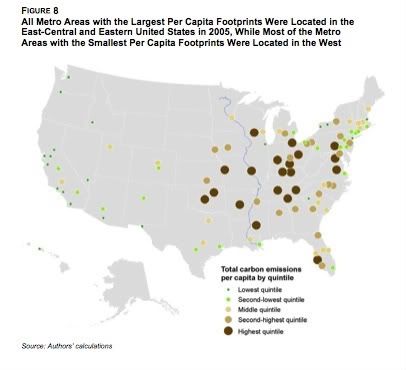South's metro areas are carbon hogs
 A new study from the Brookings Institution examines the carbon footprint of the nation's 100 largest metropolitan areas -- and finds that Southern cities dominate the list of the biggest carbon emitters.
A new study from the Brookings Institution examines the carbon footprint of the nation's 100 largest metropolitan areas -- and finds that Southern cities dominate the list of the biggest carbon emitters.
Lexington-Fayette, Ky. tops the roster of the 10 metro areas with the largest carbon footprint. Also on that list are the Southern metro areas of Louisville, Ky.; Nashville-Davidson-Murfreesboro, Tenn.; and Knoxville, Tenn. The Cincinnati-Middletown metro area, which is partly in the Southern state of Kentucky, also made the top 10.
Among the 10 metro areas with the smallest carbon footprints, only one is in the South: El Paso, Tx.
In general, the study found that metro regions with high density, compact development and rail transit offer a more carbon-efficient lifestyle than sprawling areas dependent on automobiles.
The study considered fuels used by personal and freight vehicles as well as energy used in residential buildings. It did not include emissions from commercial buildings, industry or non-highway transportation and thus captured only part of a metro area's carbon footprint. However, the findings provide insight into the policy changes needed to reduce metropolitan America's greenhouse gas emissions.
Among the recommendations the authors offer for cutting emissions are expanding transit and compact development options, engaging in regional freight planning to create more energy-efficient operations; stimulating energy-efficient retrofitting; offering incentives for location-efficient housing; and issuing a challenge to develop innovative solutions that integrate land use, transportation and energy.
"Because two-thirds of us live in the nation's largest metro areas and nearly three-quarters of economic activity takes place there, large metro areas account for most of the greenhouse gas emissions in this country," says Brookings Metropolitan Policy Program Director Bruce Katz. "For that reason, metropolitan America will play a critical role in the nation's push to restrain its emissions. Fortunately, many metro areas offer major advantages for doing that."
To read the study, titled "Shrinking the Carbon Footprint of Metropolitan America," click here.
(Map from Brookings report; click on image for larger version)
Tags
Sue Sturgis
Sue is the former editorial director of Facing South and the Institute for Southern Studies.
